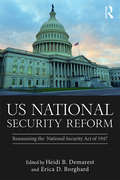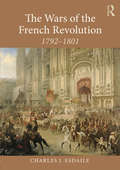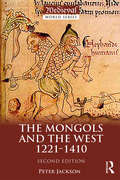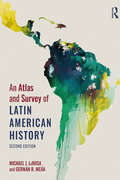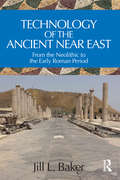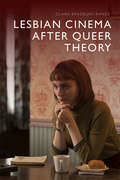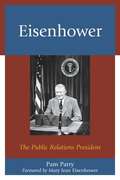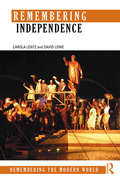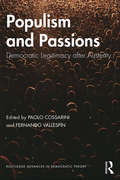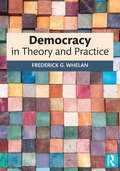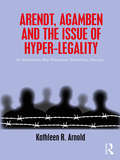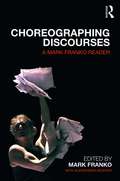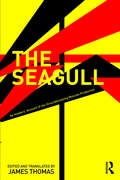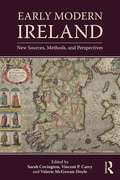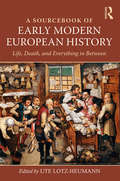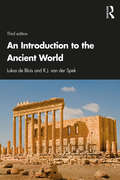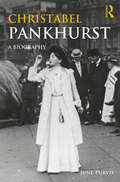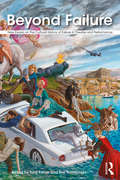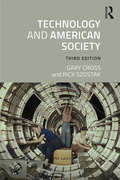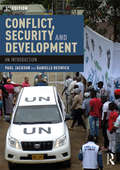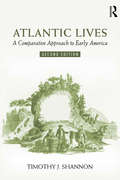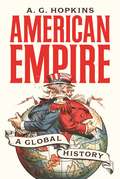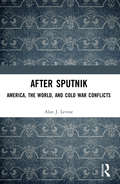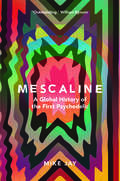- Table View
- List View
US National Security Reform: Reassessing the National Security Act of 1947 (Routledge Global Security Studies)
by Heidi B. Demarest Erica D. BorghardThis collection of essays considers the evolution of American institutions and processes for forming and implementing US national security policy, and offers diverse policy prescriptions for reform to confront an evolving and uncertain security environment. Twelve renowned scholars and practitioners of US national security policy take up the question of whether the national security institutions we have are the ones we need to confront an uncertain future. Topics include a characterization of future threats to national security, organizational structure and leadership of national security bureaucracies, the role of the US Congress in national security policy making and oversight, and the importance of strategic planning within the national security enterprise. The book concludes with concrete recommendations for policy makers, most of which can be accomplished under the existing and enduring National Security Act. This book will be of much interest to students of US national security, US foreign policy, Cold War studies, public policy and Internationl Relations in general.
The Wars of the French Revolution: 1792–1801
by Charles J EsdaileThe Wars of the French Revolution, 1792–1801 offers a comprehensive and jargon-free coverage of this turbulent period and unites political, social, military and international history in one volume. Carefully designed for undergraduate students, through twelve chapters this book offers an introduction to the origins and international context of the French Revolution as well as an in-depth examination of the reasons why war began. Aspects unpicked within the book include how France acquired a de facto empire stretching from Holland to Naples; the impact of French conquest on the areas concerned; the spread of French ideas beyond the frontiers of the French imperium; the response of the powers of Europe to the sudden expansion in French military power; the experience of the conflicts unleashed by the French Revolution in such areas as the West Indies, Egypt and India; and the impact of war on the Revolution itself. Offering extensive geographical coverage and challenging many preconceived ideas, The Wars of the French Revolution, 1792–1801 is the perfect resource for students of the French Revolution and international military history more broadly.
The Mongols and the West: 1221-1410 (The Medieval World)
by Peter JacksonThe Mongols and the West provides a comprehensive survey of relations between the Catholic West and the Mongol Empire from the first appearance of Chinggis (Genghis) Khan’s armies on Europe’s horizons in 1221 to the battle of Tannenberg in 1410. This book has been designed to provide a synthesis of previous scholarship on relations between the Mongols and the Catholic world as well as to offer new approaches and conclusions on the subject. It considers the tension between Western hopes of the Mongols as allies against growing Muslim powers and the Mongols’ position as conquerors with their own agenda, and evaluates the impact of Mongol-Western contacts on the West’s expanding knowledge of the world. This second edition takes into account the wealth of scholarly literature that has emerged in the years since the previous edition and contains significantly extended chapters on trade and mission. It charts the course of military confrontation and diplomatic relations between the Mongols and the West, and re-examines the commercial opportunities offered to Western merchants by Mongol rule and the failure of Catholic missionaries to convert the Mongols to Christianity. Fully revised and containing a range of maps, genealogical tables and both European and non-European sources throughout, The Mongols and the West is ideal for students of medieval European history and the crusades.
An Atlas and Survey of Latin American History
by Michael LaRosa German R. MejiaAn Atlas and Survey of Latin American History provides a comprehensive, accessible introduction to both the human and physical geography of Latin America and the social, cultural, political and economic events that have defined its history. Featuring 77 maps and accompanying text, the book provides topical overviews of the key developments and movements in Latin American history, ranging from the earliest human settlement to the present day. The fully updated second edition includes a new chapter on Latin America in the 21st century, featuring maps and essays on topics ranging from sports and telenovelas to the growth of the Latin American middle class and the rise and ebb of left-leaning political movements. Highly readable and beautifully designed, An Atlas and Survey of Latin American History 2e remains an engaging resource for students and others interested in Latin American history, politics, and culture.
Technology of the Ancient Near East: From the Neolithic to the Early Roman Period
by Jill L. BakerPeoples of the distant past lived comfortably in cities that boasted well-conceived urban planning, monumental architecture, running water, artistic expression, knowledge of mathematics and medicine, and more. Without the benefits of modern technology, they enjoyed all the accoutrements of modern civilization. Technology of the Ancient Near East brings together in a single volume what is known about the technology behind these acheivements, based on the archaeological, textual, historic, and scientific data drawn from a wide range of sources, focusing on subjects such as warfare, construction, metallurgy, ceramics and glass, water management, and time keeping. These technologies are discussed within the cultural, historic, and socio-economic contexts within which they were invented and the book emphasises these as the foundation upon which modern technology is based. In so doing, this study elucidates the ingenuity of ancient minds, offering an invaluable introduction for students of ancient technology and science.
Lesbian Cinema after Queer Theory
by Clara Bradbury-RanceThe unprecedented increase in lesbian representation over the past two decades has, paradoxically, coincided with queer theory’s radical transformation of the study of sexuality. In Lesbian Cinema after Queer Theory, Clara Bradbury-Rance argues that this contradictory context has yielded new kinds of cinematic language through which to give desire visual form. By offering close readings of key contemporary films such as Blue Is the Warmest Colour, Water Lilies and Carol alongside a broader filmography encompassing over 300 other films released between 1927 and 2018, the book provokes new ways of understanding a changing field of representation. Bradbury-Rance resists charting a narrative of representational progress or shoring up the lesbian’s categorisation in the newly available terms of the visible. Instead, she argues for a feminist framework that can understand lesbianism’s queerness. Drawing on a provocative theoretical and visual corpus, Lesbian Cinema after Queer Theory reveals the conditions of lesbian legibility in the twenty-first century.
Eisenhower: The Public Relations President (PDF)
by Pam Parry Mary Jean EisenhowerIn the 1950s, public relations practitioners tried to garner respectability for their fledgling profession, and one international figure helped in that endeavor. President Dwight D. Eisenhower embraced public relations as a necessary component of American democracy, advancing the profession at a key moment in its history. But he did more than believe in public relations-he practiced it. Eisenhower changed how America campaigns by leveraging television and Madison Avenue advertising. Once in the Oval Office, he maximized the potential of a new medium as the first U.S. president to seek training for television and to broadcast news conferences on television. Additionally, Eisenhower managed the news through his press office, molding the role of the modern presidential press secretary. The first president to adopt a policy of full disclosure on health issues, Eisenhower survived (politically as well as medically) three serious illnesses while in office. The Eisenhower Administration was the most forthcoming on the president's health at the time, even though it did not always live up to its own policy. In short, Eisenhower deserves credit as this nation's most innovative public relations president, because he revolutionized America's political communication process, forever changing the president's relationship with the Fourth Estate, Madison Avenue, public relations, and ultimately, the American people.
Remembering Independence: New Nations Of The Postwar World (Remembering the Modern World)
by Carola Lentz David LoweRemembering Independence explores the commemoration and remembrance of independence following the great wave of decolonisation after the Second World War. Drawing on case studies from Africa, Asia, and with reference to the Pacific, the authors find that remembering independence was, and still is, highly dynamic. From flag-raising moments to the present day, the transfer of authority from colonial rule to independent nation-states has served as a powerful mnemonic focal point. Remembering independence, in state as well as non-state constructions, connects to changing contemporary purposes and competing politic visions. Independence is a flexible idea, both a moment in time and a project, a carrier of hopes and ideals of social justice and freedom, but also of disappointments and frustrated futures. This richly illustrated volume draws attention to the broad range of media employed in remembering independence, ranging from museums and monuments to textual, oral and ritual formats of commemorative events, such as national days. Combining insights from history and anthropology, this book will be essential reading for all students of the history of empire, decolonisation, nation-building and post-colonial politics of memory.
Populism and Passions: Democratic Legitimacy after Austerity (Routledge Advances in Democratic Theory)
by Paolo Cossarini Fernando VallespínThere is a consensus that right, and left-wing populism is on the rise on both sides of the Atlantic, from Donald Trump in the United States, to Spain’s leftist Podemos. These may utilize different kinds of populist mobilizations but the fact remains that elite and mass opinion is fuelling a populist backlash. In Populism and Passions, twelve scholars engage with discourse analysis, democratic theory, and post structural political thought to study the political logic of passion for contemporary populism. Together these interdisciplinary essays demonstrate what emotional engagement implies for the spheres of politics and the social, and how it governs and mobilizes individuals. The volume presents: Theoretical and empirical implications for political analysis; Chapters on the current rise of populism, both right and left-wing trends, their different ideological features, and their relationship with the logic of passion; Theoretical implications for the future study of populism and democratic legitimacy. A timely analysis of this political phenomena in contemporary Western democracies, Populism and Passions is ideal for students and scholars in political theory, comparative politics, social theory, critical theory, cultural studies, and global studies.
Democracy in Theory and Practice
by Frederick G. WhelanDemocracy in Theory and Practice presents an authoritative overview of democratic theory today. Its distinctive approach links theory to practice, emphasizing the wide variety of institutions and procedures through which core democratic principles are implemented and the normative and practical dimensions of the choices to be made among these alternatives. Designed for courses at both the undergraduate and graduate level, the book features eighteen chapters organized thematically and divided into sections and subsections for easy reference; historical and current examples, citations for specific ideas, annotated references, and further readings throughout enhance the volume's utility for students, scholars, and researchers. Sidebars give biographical sketches of classic theorists and democratic ideas from the US founders and constitutional tradition. Featured topics discussed include: Majority Rule; Participation; Deliberation; Accountability; Representation; Constitutionalism; Electoral Laws; Parties; Legislative, Executive, and Judicial Functions. The Boundary Problem; The "All-Affected" Principle; Contested Senses of Liberal and Procedural Democracy; The Pros and Cons of Term Limits; Proportional Representation; Referendums; Problems of Democratic Transparency and Reversibility. Written by a leading authority in the field, Frederick G. Whelan encourages us to think of the many alternative ways of putting democracy into practice and of these alternatives as requiring choices. This diversity means that there is no unique or correct democratic outcome from a given set of preferences, since outcomes are shaped by the methods followed in reaching them.
Arendt, Agamben and the Issue of Hyper-Legality: In Between the Prisoner-Stateless Nexus
by Kathleen R. ArnoldIn the Origins of Totalitarianism, Hannah Arendt famously argued that the stateless were so rightless, that it was better to be a criminal who at least had some rights and protections. In this book, Kathleen R. Arnold examines Arendt’s comparison in the context of post-1996 U.S. criminal and immigration policies, arguing that the criminal-stateless binary is significant to contemporary politics and yet flawed. A key distinction made today is that immigrant detention is not imprisonment because it is a civil system. In turn, prisoners are still citizens in some respects but have relatively few rights since the legal underpinnings of "cruel and unusual" have shifted in recent times. The two systems – immigrant detention and the prison system – are also concretely related as they often house both populations and utilize the same techniques (such as administrative segregation). Arnold compellingly argues that prisoners are essentially made into foreigners in these spaces, while immigrants in detention are cast as outlaws. Examining legal theory, political theory and discussing specific cases to illustrate her claims, Arendt, Agamben and the Issue of Hyper-Legality operates on three levels to expose the degree to which prisoners’ rights have been suspended and how immigrant policy and detention cast foreigners as inherently criminal. Less talked about, the government in turn expands sovereign, discretionary power and secrecy at the expense of openness, transparency and democratic community. This book will be of interest to scholars and students of contemporary political theory, philosophy and law, immigration, and incarceration.
Choreographing Discourses: A Mark Franko Reader
by Mark FrankoChoreographing Discourses brings together essays originally published by Mark Franko between 1996 and the contemporary moment. Assembling these essays from international, sometimes untranslated sources and curating their relationship to a rapidly changing field, this Reader offers an important resource in the dynamic scholarly fields of Dance and Performance Studies. What makes this volume especially appropriate for undergraduate and graduate teaching is its critical focus on twentieth- and twenty-first-century dance artists and choreographers – among these, Oskar Schlemmer, Merce Cunningham, Kazuo Ohno, William Forsythe, Bill T. Jones, and Pina Bausch, some of the most high-profile European, American, and Japanese artists of the past century. The volume’s constellation of topics delves into controversies that are essential turning points in the field (notably, Still/Here and Paris is Burning), which illuminate the spine of the field while interlinking dance scholarship with performance theory, film, visual, and public art. The volume contains the first critical assessments of Franko’s contribution to the field by André Lepecki and Gay Morris, and an interview incorporating a biographical dimension to the development of Franko’s work and its relation to his dance and choreography. Ultimately, this Reader encourages a wide scope of conversation and engagement, opening up core questions in ethics, embodiment, and performativity.
The Seagull: An Insiders’ Account of the Groundbreaking Moscow Production
by Anatoly EfrosThis book is an insiders’ account of the groundbreaking Moscow production of Chekhov's The Seagull directed by Anatoly Efros in 1966, which heralded a paradigm shift in the interpretation and staging of Chekhov’s plays. It is a unique glimpse behind the curtain of the laboratory of new Russian theatre in the twentieth century. Efros' articles about Chekhov and The Seagull, his diaries, interviews and conversations, and most importantly the original rehearsal records combine to form an in-depth account of of the director and his working process. This is an essential book for anyone with an interest in Chekhov and the history of modern Russian theatre.
Early Modern Ireland: New Sources, Methods, and Perspectives (Countries in the Early Modern World)
by Sarah Covington Valerie McGowan-Doyle Vincent CareyEarly Modern Ireland: New Sources, Methods, and Perspectives offers fresh approaches and case studies that push the field of early modern Ireland, and of British and European history more generally, into unexplored directions. The centuries between 1500 and 1700 were pivotal in Ireland’s history, yet so much about this period has remained neglected until relatively recently, and a great deal has yet to be explored. Containing seventeen original and individually commissioned essays by an international and interdisciplinary group of leading and emerging scholars, this book covers a wide range of topics, including social, cultural, and political history as well as folklore, medicine, archaeology, and digital humanities, all of which are enhanced by a selection of maps, graphs, tables, and images. Urging a reevaluation of the terms and assumptions which have been used to describe Ireland’s past, and a consideration of the new directions in which the study of early modern Ireland could be taken, Early Modern Ireland: New Sources, Methods, and Perspectives is a groundbreaking collection for students and scholars studying early modern Irish history.
A Sourcebook of Early Modern European History: Life, Death, and Everything in Between
by Ute Lotz-HeumannA Sourcebook of Early Modern European History not only provides instructors with primary sources of a manageable length and translated into English, it also offers students a concise explanation of their context and meaning. By covering different areas of early modern life through the lens of contemporaries’ experiences, this book serves as an introduction to the early modern European world in a way that a narrative history of the period cannot. It is divided into six subject areas, each comprising between twelve and fourteen explicated sources: I. The fabric of communities: Social interaction and social control; II. Social spaces: Experiencing and negotiating encounters; III. Propriety, legitimacy, fi delity: Gender, marriage, and the family; IV. Expressions of faith: Offi cial and popular religion; V. Realms intertwined: Religion and politics; and, VI. Defining the religious other: Identities and conflicts. Spanning the period from c. 1450 to c. 1750 and including primary sources from across early modern Europe, from Spain to Transylvania, Italy to Iceland, and the European colonies, this book provides an excellent sense of the diversity and complexity of human experience during this time whilst drawing attention to key themes and events of the period. It is ideal for students of early modern history, and of early modern Europe in particular.
An Introduction to the Ancient World
by Lukas de Blois R.J. van der SpekAn Introduction to the Ancient World offers a thorough survey of the history of the ancient Near East, Greece and Rome. Covering the social, political, economic and cultural processes that have influenced later western and Near Eastern civilisations, this volume considers subjects such as the administrative structures, economies and religions of the ancient Near East, Athenian democracy, the development of classical Greek literature, the interaction of cultures in the Hellenistic world, the political and administrative system of the Roman Republic and empire, and the coming of Christianity, all within the broad outline of political history. This third edition is thoroughly updated and some chapters are completely rewritten to cover recent historical research. Changes include: more attention to economic structures and developments, and to the history of the later Roman Empire (third to sixth centuries AD); incorporation of the results of recent archaeological and historical research, and recently published studies of ancient literature; ‘boxes’ that support the main text, on topics including economic and political systems, religion and terminology; redrawn maps and new, higher-quality images; the inclusion of useful websites in the bibliography. An Introduction to the Ancient World provides an easily readable, user-friendly, integrated overview for students of ancient history, classics and archaeology. Lavishly illustrated, clearly and concisely written, and well organised, this fully updated and revised edition will remain a key resource for students beginning to investigate the civilisations of the ancient Mediterranean.
Christabel Pankhurst: A Biography (Women's and Gender History)
by June PurvisTogether with her mother, Emmeline, Christabel Pankhurst co-led the single-sex Women’s Social and Political Union (WSPU), founded in 1903 and soon regarded as the most notorious of the groupings campaigning for the parliamentary vote for women. A First Class Honours Graduate in Law, the determined and charismatic Christabel, a captivating orator, revitalised the women’s suffrage campaign by rousing thousands of women to become suffragettes, as WSPU members were called, and to demand rather than ask politely for their democratic citizenship rights. A supreme tactician, her advocacy of ‘militant’, unladylike tactics shocked many people, and the political establishment. When an end to militancy was called on the outbreak of war in 1914, she encouraged women to engage in war work as a way to win their enfranchisement. Four years later, when enfranchisement was granted to certain categories of women aged thirty and over, she stood unsuccessfully for election to parliament, as a member of the Women’s Party. In 1940 she moved to the USA with her adopted daughter, and had a successful career there as a Second Adventist preacher and writer. However, she is mainly remembered for being the driving force behind the militant wing of the women’s suffrage movement. This full-length biography, the first for forty years, draws upon feminist approaches to biography writing to place her within a network of supportive female friendships. It is based upon an unrivalled range of previously untapped primary sources.
Beyond Failure: New Essays on the Cultural History of Failure in Theatre and Performance
by Tony Fisher Eve KatsourakiIn setting foot on stage, every performer risks the possiblity of failure. Indeed, the very performance of any human action is inextricable from its potential not to succeed. This inherent potential has become a key critical trope in contemporary theatre, performance studies, and scholarship around visual cultures. Beyond Failure explores what it means for our understanding not just of theatrical practice but of human social and cultural activity more broadly. The essays in this volume tackle contemporary debates around the theory and poetics of failure, suggesting that in the absence of success can be found a defiance and hopefulness that points to new ways of knowing and being in the world. Beyond Failure offers a unique and engaging approach for students and practitioners interested not only in the impact of failure on the stage, but what it means for wider social and cultural debates.
Technology and American Society: A History
by Gary Cross Richard SzostakProviding a global perspective on the development of American technology, Technology and American Society offers a historical narrative detailing major technological transformations over the last three centuries. With coverage devoted to both dramatic breakthroughs and incremental innovations, authors Gary Cross and Rick Szostak analyze the cause-and-effect relationship of technological change and its role in the constant drive for improvement and modernization. This fully-updated 3rd edition extends coverage of industry, home, office, agriculture, transport, constructions, and services into the twenty-first century, concluding with a new chapter on recent electronic and technological advances. Technology and American Society remains the ideal introduction to the myriad interactions of technological advancement with social, economic, cultural, and military change throughout the course of American history.
Conflict, Security and Development: An Introduction
by Paul Jackson Danielle BeswickThis textbook draws on academic theory, field research and policy developments to provide an overview of the connections between security and development, before, during and after conflict. This third edition is revised and updated to take account of changes that have occurred in both policy and academic arenas which are relevant to students and practitioners in this area. In addition, there is a new chapter on memory and memorialisation after conflict. In an interdependent world, it is often argued that the challenges of underdevelopment and insecurity have global implications. This textbook charts an accessible course through these complex debates, providing a comprehensive introduction for those encountering these issues for the first time. The main aims of the revised edition are: to set out how thinking on conflict, security and development has changed over time and continues to evolve; to explore the consequences of these changes, particularly for the theory and practice of development and security promotion; to introduce a range of case studies from across the globe, in order to explore the implications of a combined approach to security and development. The authors are experienced in both the theory and the practice of this field, and illustrate the links between conflict, security and development with practical examples, drawing on key case studies from the past twenty years. Each chapter is informed by student pedagogy, and the book will be essential reading for all students of development studies, war and conflict studies, and human security, and is recommended for students of international security and international relations in general.
Atlantic Lives: A Comparative Approach to Early America
by Timothy ShannonAtlantic Lives offers insight into the lived experiences of a range of actors in the early modern Atlantic World. Organized thematically, each chapter features primary source selections from a variety of non-traditional sources, including travel narratives from West Africa, the Caribbean, and Latin America. The fully revised and expanded second edition goes into even greater depth in exploring the diverse roles and experiences of women, Native Americans, and Africans, as well as the critical theme of emerging capitalism and New World slavery. New chapters also address captivity experiences, intercultural religious encounters, and interracial sexuality and marriage. With classroom-focused discussion questions and suggested additional readings accompanying each chapter, Atlantic Lives provides students with a wide-ranging introduction to the many voices and identities that comprised the Atlantic World.
American Empire: A Global History (America in the World #25)
by A. G. HopkinsA new history of the United States that turns American exceptionalism on its headAmerican Empire is a panoramic work of scholarship that presents a bold new global perspective on the history of the United States. Drawing on his expertise in economic history and the imperial histories of Britain and Europe, A. G. Hopkins takes readers from the colonial era to today to show how, far from diverging, the United States and Western Europe followed similar trajectories throughout this long period, and how America’s dependency on Britain and Europe extended much later into the nineteenth century than previously understood.In a sweeping narrative spanning three centuries, Hopkins describes how the revolt of the mainland colonies was the product of a crisis that afflicted the imperial states of Europe generally, and how the history of the American republic between 1783 and 1865 was a response not to the termination of British influence but to its continued expansion. He traces how the creation of a U.S. industrial nation-state after the Civil War paralleled developments in Western Europe, fostered similar destabilizing influences, and found an outlet in imperialism through the acquisition of an insular empire in the Caribbean and Pacific. The period of colonial rule that followed reflected the history of the European empires in its ideological justifications, economic relations, and administrative principles. After 1945, a profound shift in the character of globalization brought the age of the great territorial empires to an end.American Empire goes beyond the myth of American exceptionalism to place the United States within the wider context of the global historical forces that shaped the Western empires and the world.
American Empire: A Global History (America in the World #25)
by A. G. HopkinsA new history of the United States that turns American exceptionalism on its headAmerican Empire is a panoramic work of scholarship that presents a bold new global perspective on the history of the United States. Drawing on his expertise in economic history and the imperial histories of Britain and Europe, A. G. Hopkins takes readers from the colonial era to today to show how, far from diverging, the United States and Western Europe followed similar trajectories throughout this long period, and how America’s dependency on Britain and Europe extended much later into the nineteenth century than previously understood.In a sweeping narrative spanning three centuries, Hopkins describes how the revolt of the mainland colonies was the product of a crisis that afflicted the imperial states of Europe generally, and how the history of the American republic between 1783 and 1865 was a response not to the termination of British influence but to its continued expansion. He traces how the creation of a U.S. industrial nation-state after the Civil War paralleled developments in Western Europe, fostered similar destabilizing influences, and found an outlet in imperialism through the acquisition of an insular empire in the Caribbean and Pacific. The period of colonial rule that followed reflected the history of the European empires in its ideological justifications, economic relations, and administrative principles. After 1945, a profound shift in the character of globalization brought the age of the great territorial empires to an end.American Empire goes beyond the myth of American exceptionalism to place the United States within the wider context of the global historical forces that shaped the Western empires and the world.
After Sputnik: America, the World, and Cold War Conflicts
by Alan J. LevineOn October 4, 1957 in the midst of the Cold War, the Soviet Union launched Sputnik I, the first artificial earth satellite. For the West, and especially the United States, it was a shattering blow to national morale and pride. It led to a deep-seated fear that the Soviet Union would surpass the United States in both technology and power and that even nuclear war might be near. After Sputnik shows that the late 1950s were not an era of complacency and smugness, but were some of the most anxious years in American history. The Cold War was by no means a time of peace. It was an era of a different kind of battle—one that took place in negotiations and in the internal affairs of many countries, but not always on the battlefield. While many choose to remember President Eisenhower as a near-pacifist, his actions in Lebanon, the Taiwan Straits crisis, Berlin, and elsewhere proved otherwise. Seconded by his able secretary of state, John Foster Dulles, he steered America though some of the most difficult parts of the Cold War, not always succeeding, but preventing disaster. The Middle East and Berlin crises, the Indonesian Civil War, Fidel Castro’s rise to power, and other events are all bluntly discussed in the light of Western, and other, illusions and delusions. In this engaging history, Alan J. Levine delves deeply into this often misrepresented period of history, and provides new insight into one of the most formative decades in American history.
Mescaline: A Global History of the First Psychedelic
by Mike JayA definitive history of mescaline that explores its mind-altering effects across cultures, from ancient America to Western modernity Mescaline became a popular sensation in the mid-twentieth century through Aldous Huxley’s The Doors of Perception, after which the word “psychedelic” was coined to describe it. Its story, however, extends deep into prehistory: the earliest Andean cultures depicted mescaline-containing cacti in their temples. Mescaline was isolated in 1897 from the peyote cactus, first encountered by Europeans during the Spanish conquest of Mexico. During the twentieth century it was used by psychologists investigating the secrets of consciousness, spiritual seekers from Aleister Crowley to the president of the Church of Jesus Christ of Latter-day Saints, artists exploring the creative process, and psychiatrists looking to cure schizophrenia. Meanwhile peyote played a vital role in preserving and shaping Native American identity. Drawing on botany, pharmacology, ethnography, and the mind sciences and examining the mescaline experiences of figures from William James to Walter Benjamin to Hunter S. Thompson, this is an enthralling narrative of mescaline’s many lives.
